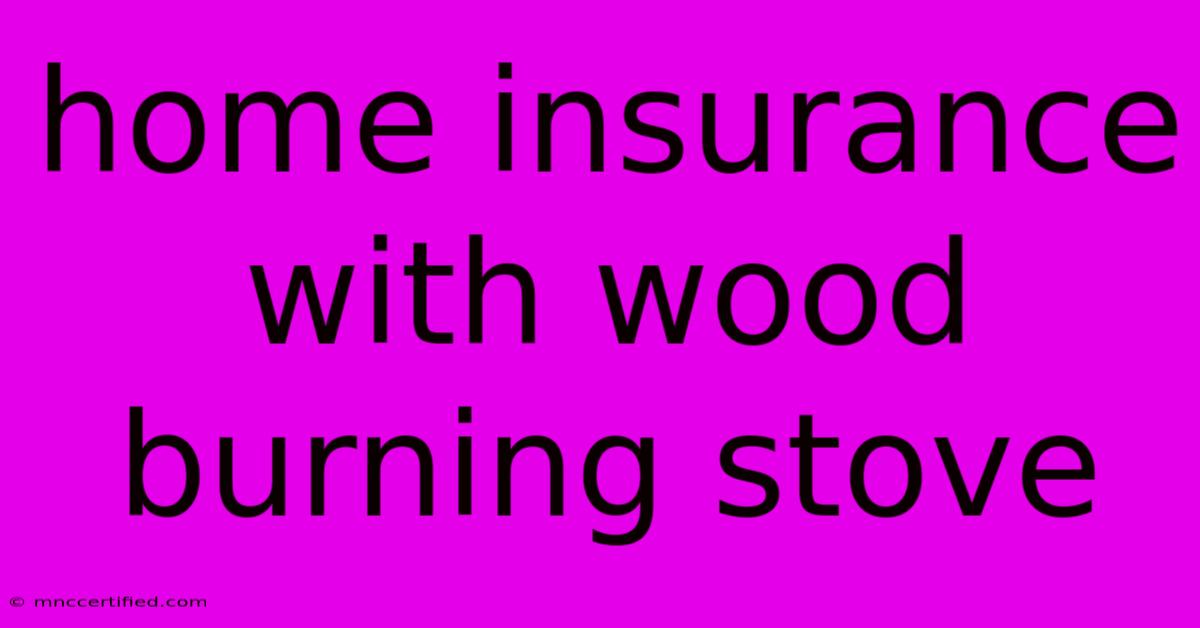Home Insurance With Wood Burning Stove

Table of Contents
Keeping Your Home Safe and Warm: Understanding Home Insurance with a Wood Burning Stove
A wood burning stove can add warmth, ambiance, and a touch of rustic charm to your home. But it's essential to remember that owning a wood burning stove also presents certain risks, which can impact your home insurance. This article will delve into the details of home insurance with a wood burning stove, addressing key considerations and helping you make informed decisions to keep your home safe and protected.
Understanding the Risks
While a wood burning stove can be a valuable asset, it's important to be aware of potential risks associated with its use:
- Fire hazards: Improper installation, maintenance, and operation can lead to chimney fires, creosote buildup, and other fire hazards.
- Smoke damage: Smoke from a wood burning stove can damage walls, furniture, and belongings, leading to significant repair costs.
- Carbon monoxide poisoning: Incomplete combustion can release harmful carbon monoxide into your home, posing a serious health risk.
How Home Insurance is Affected
Most home insurance policies cover damage caused by fire, smoke, and carbon monoxide poisoning. However, the presence of a wood burning stove can influence your insurance premiums and coverage in several ways:
- Increased premium: Insurance companies generally view homes with wood burning stoves as higher risk due to potential fire hazards. This means you might pay a slightly higher premium than homeowners without a wood burning stove.
- Specific exclusions: Some policies may have specific exclusions for damage caused by negligence or improper operation of the stove, such as failing to clean the chimney regularly.
- Additional requirements: Your insurer might require you to meet certain safety standards, like having your chimney inspected annually, installing smoke detectors, and ensuring proper ventilation.
Protecting Yourself and Your Home
To mitigate risks and maintain adequate coverage, consider these steps:
- Professional Installation: Ensure your wood burning stove is professionally installed by a qualified contractor. They can ensure proper venting and safety measures are in place.
- Regular Maintenance: Regularly clean the chimney, inspect the stove for cracks or damage, and replace worn-out parts as needed.
- Safe Operation: Use dry, seasoned wood, never leave the stove unattended, and keep flammable materials away from the unit.
- Smoke Detectors: Install working smoke detectors on every level of your home, as well as in close proximity to the stove.
- Carbon Monoxide Detector: Install a carbon monoxide detector near the stove to alert you of potential leaks.
- Inform your Insurer: Be transparent with your insurer about the presence of your wood burning stove. This allows them to accurately assess your risk and tailor your policy accordingly.
Choosing the Right Home Insurance Policy
When choosing a home insurance policy with a wood burning stove, consider:
- Coverage limits: Ensure your policy provides adequate coverage for fire, smoke, and carbon monoxide damage, taking into account the value of your home and belongings.
- Specific exclusions: Carefully read your policy and understand any exclusions related to wood burning stoves.
- Safety requirements: Confirm your policy's requirements for maintaining your stove and ensuring safety standards.
- Compare quotes: Obtain quotes from multiple insurers to compare coverage options and premiums.
Conclusion
A wood burning stove can enhance your home's comfort and charm, but it's crucial to be aware of the associated risks and take necessary precautions. By implementing proper installation, maintenance, and safety practices, and by informing your insurer, you can safeguard your home and ensure you have the right coverage to handle unforeseen events. Remember, a well-maintained and responsibly operated wood burning stove can be a safe and enjoyable addition to your home.

Thank you for visiting our website wich cover about Home Insurance With Wood Burning Stove. We hope the information provided has been useful to you. Feel free to contact us if you have any questions or need further assistance. See you next time and dont miss to bookmark.
Featured Posts
-
Putin Congratulates Trump On Election Win
Nov 09, 2024
-
All Price Insurance Cottonwood Arizona
Nov 09, 2024
-
Tony Todd Dead Actor Known For Candyman Role
Nov 09, 2024
-
Judge Invalidates Parole In Place Program
Nov 09, 2024
-
See All 2025 Grammy Award Nominees
Nov 09, 2024